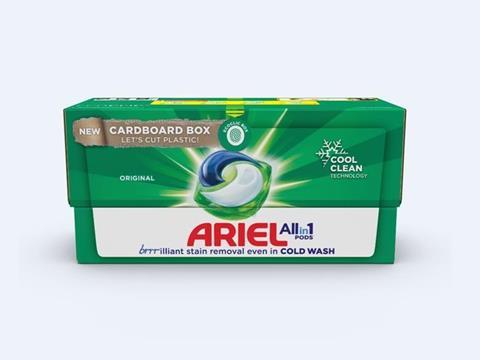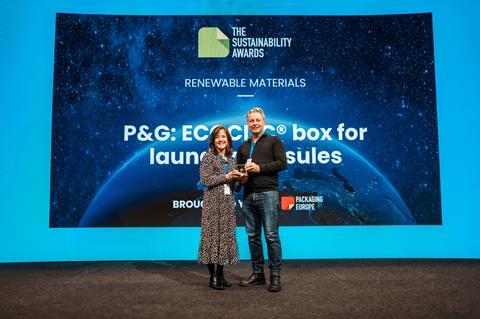
Following Packaging Europe’s Sustainability Awards which took place in Amsterdam this November, we spoke to Samantha King, vice president of research and development at Procter & Gamble about the company’s win in the commercialized Renewable Materials category with its ECOCLIC box for liquid laundry capsules.
You’re a Sustainability Awards 2023 winner in the commercialized Renewable Materials category. Congratulations! To start off, could you summarise your entry, in less than 50 words?
Ariel’s innovative ECOCLIC box is the first Ariel PODS pack made with cardboard packaging that’s fully recyclable in at-home paper recycling streams and is both certified as child safe and designed to be inclusive, making the laundry experience easier for everyone!
Why do you think the judges were impressed with your entry? Tell us what is innovative about your project and/or about its impact on packaging sustainability.
When designing the ECOCLIC box, we knew it needed to deliver a safe, more sustainable, and inclusive packaging experience for consumers. It was a real challenge to make sure we hit the mark across these three areas, however I think the judges were impressed by our dedication to achieving what we set out to do without making any compromises.
One of the first and biggest hurdles we had to overcome was moving from plastic to cardboard. I think anyone who works in the packaging industry understands the challenge of working with a new packaging material, particularly cardboard. The first hurdle was whether cardboard was durable and safe enough to meet the criteria for child safety certification. We also needed to consider how we were going to produce cardboard packaging at scale!
To solve both challenges, we needed to specifically look at the cardboard mix we could use to retain the strength of the packaging while maximising recycled materials. This process underwent many iterations, but the final pack is a mixture of at least 70% recycled fibres and virgin cardboard, sourced from well-managed FSC-certified forests.
This mix means we don’t need to compromise on the pack’s recyclability and can deliver a robust and moisture resistant box, enabling the product to stay safe and intact even when stored in a humid environment. This breakthrough marks an important step in our journey to reduce plastic. In fact, if all Ariel PODS users in Europe switched to the new cardboard ECOCLIC box, up to 6,500 tonnes of plastic could be saved each year.

The second challenge was balancing child safety with making the packaging easy and intuitive for all adults to open, so that those with dexterity and joint issues could still use it. We found our solution through extensive consumer testing when our team observed how our adult and child consumer testers held and interacted with the prototypes.
The ECOCLIC opening system was re-designed in line with an adult handspan. We incorporated an audio-cue ‘click’, letting consumers know the pack is safely closed and providing reassurance to those with sight issues.
As part of our team, P&G company accessibility leader Sumaira Latif, who has been blind since she was a teenager, provided invaluable advice in this area. Thanks to her advice, Ariel’s ECOCLIC box features a newly created tactile marker as well as the NaviLens QR code to help blind and visually impaired consumers easily identify the ECOCLIC box and access information about the product.
Developed by P&G, the tactile marker – shaped like a washing machine – is embossed on the outside of the box on the top panel, signposting that the box contains laundry detergent. Then the NaviLens QR code (which can be scanned more than 12 times further away than usual QR or barcodes) triggers an audio-description of the product to help identify it in store, also giving important usage and dosage information to visually impaired consumers.
How has your innovation/initiative been received?
Since we launched the ECOCLIC box in Europe, we have received incredible feedback from our consumers that has really validated the work we put in to create this packaging. We’ve had people take the time to write to us and say thank you for designing a box that they can use without having to ask anyone for help. It’s great to know this box is helping to give people a bit more autonomy and satisfaction in their laundry process within everyday life.
In addition, the ECOCLIC box has received multiple industry recognitions and awards since last summer including the 2022 German Packaging award, Dow packaging Diamond award and PAC Best of Show award. We also won a Cannes Lions award for both the impact on consumers – the inclusive design - and for sustainability.

You were the 2023 winner in the Renewable Materials category. What do you see as the key demands and challenges in relation to developing new materials from renewable feedstocks for packaging applications?
I believe in the power of the science-based Life Cycle Analysis (LCA) tool to guide future packaging developments and ensure they reduce our impact on the environment. Conducting LCAs for our products means we understand their impact from cradle to grave. It helps us to focus our efforts where it matters most so we can reduce our environmental impact.
With packaging, we need to minimize the amount of virgin materials in our packaging while striving for circularity. The new ECOCLIC box is vital to Ariel’s commitment to help reduce virgin plastic of our Fabric Care business by 30% in Europe by 2025.
We know from the LCA of laundry that the ‘in-use’ phase accounts for 60% of laundry’s carbon footprint (a simplified breakdown based on the European average) which is primarily due to the heating of the water. By simply turning down the temperature of your wash even by 10 degrees from 40 to 30 degrees Celsius, you can reduce laundry CO2 emissions by 35%. Our Ariel All-in-1 PODS have been formulated to deliver cleaning performance even in colder and quicker cycles to enable people to wash at colder temperatures.
What do you think are the main opportunities in this area or what future innovations do you predict in this area?
Every one of our innovations puts sustainability and consumer delight front and centre. We take a science-based approach to pinpoint where we can do better and prioritise innovations that will have the biggest consumer and environmental impact. As part of this, we will continue to focus on inclusive packaging design for better accessibility and work with partners, communities, and consumers to ensure we’re creating the packaging solutions people need.
If you liked this article, you might also enjoy:
The L’Oréal approach to packaging sustainability
What steps is Apple taking to make its packaging more sustainable?
How did Brazil achieve its 100% aluminium can recycling rate – and can it be replicated in the EU?
Experts have their say on the EU’s Packaging and Packaging Waste Directive revisions











No comments yet